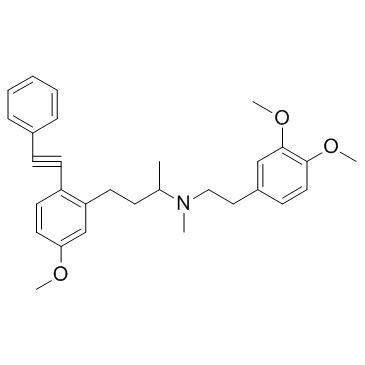McN5691 (RWJ26240) (Synonyms: RWJ26240) |
| رقم الكتالوجGC32636 |
McN5691 (RWJ26240) هو مانع لقنوات الكالسيوم الحساسة للجهد.
Products are for research use only. Not for human use. We do not sell to patients.

Cas No.: 99254-95-2
Sample solution is provided at 25 µL, 10mM.
McN5691 is a voltage-sensitive calcium channel blocker.
McN5691 (1 and 10 μM) prevents 60 mM KCl-induced contraction and calcium uptake and causes concentration-dependent relaxation (EC50=190 μM) of 30 mM KCl-contracted aortic rings. At or below 10 μM, McN5691 (McN-5691) has no effects on basal tone or calcium uptake (45Ca) in isolated rings of rabbit thoracic aorta. McN5691 causes complete high affinity inhibition (Kd=39.5 nM) of specific diltiazem binding to the benzothiazepine receptor on the voltage-sensitive calcium channel in skeletal muscle microsomal membranes. In contrast to diltiazem, McN5691 inhibits specific dihydropyridine receptor binding, but the effect is biphasic with high (Kd=4.7 nM) and low (Kd=919.8 nM) affinity components. McN5691 inhibits norepinephrine (NE)-induced contraction (10 μM) and calcium uptake (1 and 10 μM) and causes concentration-dependent relaxation (EC50=159 μM) of 1 μM NE-contracted rings of rabbit thoracic aorta[1].
The excretion and metabolism of a 2-ethynylbenzenealkanamine analog, antihypertensive McN5691 (RWJ-26240), in beagle dogs is investigated. A total of 96.8% and 2.8% of the radioactive dose are excreted in feces and urine, respectively, during the 7 days after oral administration of 14C-McN5691. Of the radioactive dose, 96.8% and 2.8% is recovered in feces and urine, respectively, in the 7 days after oral administration of 14C-McN5691. More than 87% of the dose is excreted in feces during the 48 hours. McN5691 is extensively metabolized in dogs. Unchanged McN5691 is found in less than 0.1% and 19% of the dose in the 0-24 hour urine and 0-48 hour fecal extract, respectively, and 36% of the sample in the 4 hour plasma[2]. In the McN5691 (McN-5691) study, vascular resistances tend to be higher in spontaneously hypertensive rat (SHR) than in Wistar-Kyoto (WKY) but the differences are statistically significant only in the cerebellum and the midbrain[3].
[1]. Flaim SF, et al. Structurally novel antihypertensive compound, McN-5691, is a calcium channel blocker in vascular smooth muscle. J Pharmacol Exp Ther. 1991 Jan;256(1):279-88. [2]. Wu WN, et al. Excretion and metabolism of the antihypertensive agent, RWJ-26240 (McN-5691) in dogs. Drug Metab Dispos. 1998 Feb;26(2):115-25. [3]. Flaim SF, et al. Effects of the novel calcium channel blocker, McN-5691, on cardiocirculatory dynamics and cardiac output distribution in conscious spontaneously hypertensive rat. J Cardiovasc Pharmacol. 1988 Apr;11(4):489-500.
Average Rating: 5 (Based on Reviews and 16 reference(s) in Google Scholar.)
GLPBIO products are for RESEARCH USE ONLY. Please make sure your review or question is research based.
Required fields are marked with *




















